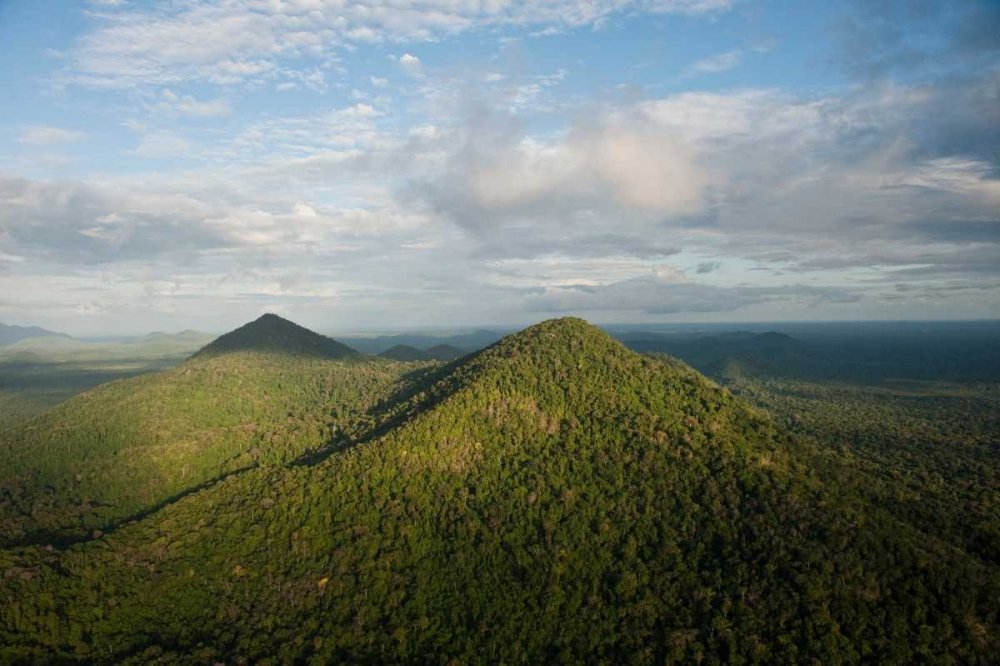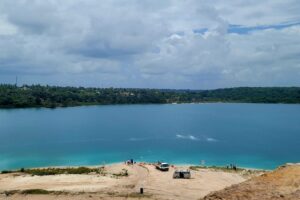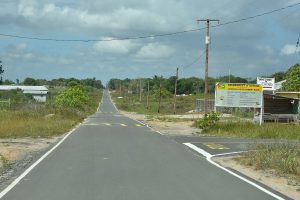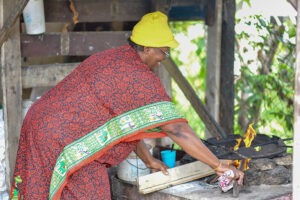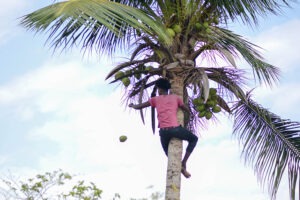Deep within the dense forest of Guyana lies a precious protected area called – the Kanuku Mountains. Lying in the heart of Guyana, the Kanuku Mountains, are admired for their vast stretches of unspoilt forest filled with wildlife. The winding, brownish rivers and the flowing creeks that are ever so clear, vibrant with crustaceans and the blue misted peaks that touches the sky, all make the Kanuku Mountains the rainforest wilderness that you fantasize about.
The Kanuku Mountains has been described as a group of mountains in Guyana. The name means ‘forest’ in the Wapishana language which refers to the rich diversity of wildlife found there. It is located in the Upper Takutu-Upper Essequibo region. The Eastern Kanuku Mountains and the Western Kanuku Mountains are separated by the Rupununi River.
The Kanukus’ Vast Forest And Wildlife
The Kanukus contain habitats as diverse as gallery forests, lowland forests and montane evergreen forests and savannah, and is home to 60% of all birds known to exist in Guyana. At least five of the South American giants live in the Kanuku Mountains — the Harpy Eagle, Black Caiman, Giant River Otter, Arapaima Fish and the Giant Anteater.
Did You Know? One hundred and fifty mammal species, or 80% of all mammals found in Guyana, live in the Kanuku Mountains.
The Kanukus’ Community
The Kanuku Mountains are located in the Rupununi region of southwestern Guyana, a tropical country sitting on the northern coast of South America within the highly forested Guiana Shield. The Rupununi is part of administrative Region Nine (Upper Takutu, Upper Essequibo), the largest of the 10 administrative regions of the country.
The area around the Kanuku Mountains is populated mainly by the indigenous Macushi and Wapishana people who live in 21 communities. These communities interact with and use the resources of the mountains to sustain their mainly subsistence lifestyle. There is also a mix of coastland, Brazilian and western cultural influences in the region.
Tip: The Kanuku Mountains rise to almost 3,000 ft.
Important Facts About The Kanuku Mountains
Large and Protected Area: At 6,110 km2, the Kanukus are Guyana largest protected area, representing 4% of its total forest.
Exploration: Because the ranges are largely unexplored, there are secrets, places and species that are yet to be explored.
Biodiversity: It is said to be the most biodiverse place in all of Guyana. It is home to hundreds of species of mammals as said before along with birds, reptiles, amphibians, fish and over 1,500 plants.
Guyana’s Giants: The Kanukus promote healthy population of many of Guyana’s Giants.
Surroundings: The Kanukus form the southern ridge of an ancient rift valley with the southern Pakaraima Mountains or Iwokrama Range to the North and the North Rupununi savannas forming the valley floor. The area is drained by the Takutu River in the west and by the Rupununi River to the east. The Takutu drains into the Rio Branco in Brazil before joining the Amazon Basin. The Rupununi River flows into the Essequibo, Guyana’s largest river.
Tour To The Kanuku Mountains
Wilderness Explorer
- Day 1 – Arrive in Guyana and transfer to Georgetown. Overnight at Cara Lodge.
- Day 2 – Georgetown city tour. Overnight at Cara Lodge.
- Day 3 – Fly to Lethem and 4X4 to Dadanawa Ranch. Overnight at Dadanawa Ranch.
- Day 4 – Explore the ranch and work the vaqueros. Overnight at Dadanawa Ranch.
- Day 5 – Travel to Sand Creek by canoe. Cruise through small rapids or help guide the boat through rocky outcrops as you make your way to the Wapisiana Indian community at Sand Creek. Hammock Camp at Sand Creek.
- Day 6 – Follow the Rupununi River to Crabwood Creek. Continue the boat journey and travel down the Rupununi River through occasional rapids and into the Kanuku Mountains to Crabwood Creek. This area is uninhabited apart from a few traditional farmers from Sand Creek. The voyage enters the Kanuku Mountains. Visit an Amerindian Farm. Hammock Camp on Riverbank.
- Day 7 – Continue on Rupununi River to Maparri. You will have the opportunity to see Black and Spectacled Caiman, Puma, Tapir, Giant Rivers Otters and Turtles. Turn into the Maparri River, a tributary of the Rupununi River, and travel six miles to the Maparri Wilderness Camp set on the river bank overlooking a small waterfall. Relax at the Maparri Wilderness Camp.
- Day 8 – Explore widlife and nature around Maparri. Explore forest trails that lead into the virgin Kanuku Mountains in search of Harpy Eagle, Guiaian Cock-of-the-rock, Cotingas, Three-toed Sloth, Tyra and many other exotic animals. The exploration continues on foot, trekking through the forest on steep trails and exploring the seemingly endless series of small waterfalls that are fed by the steep mountain slopes. The river offers good fishing with light tackle with spinners or fly and heavy hand line at night for Catfish and Haimara (large predator fish) in clear water. Night boat trip to spot wildlife and see Electric Eels and Dwarf Caiman by torchlight, and the river is also home to Giant River Otters. Relax at the Maparri Wilderness Camp.
- Day 9 – More wildlife and nature around Maparri. Relax at the Maparri Wilderness Camp.
- Day 10 – Travel by river to Karanambu Ranch. Overnight at Karanambu Lodge.
- Day 11 – Birdwatching, hikes, and tending to otters at Karanambu. Overnight at Karanambu Lodge.
- Day 12 – Fly to Georgetown. Overnight at Cara Lodge.
Contact Information:
41 Fourth Street, Campbellville, Georgetown, Guyana, South America, WildernessGuyana.
- [+592] 227-7698
- [+592] 624-2225 Emergency
- [+44] 020 8417 1585
- [+1] (202) 630-7698
- [+46] 709 70 79 19
- [+41] 56 222 9978
Watch “Above Guyana – The Kanuku Mountain Range”
Kanuku Mountains In Guyana
The Kanuku Mountains are a sight to see and it gives off a feeling that needs to be experienced. The exotic wildlife, the surroundings and the unique community all make the Kanukus a place to visit. You can put it on your ‘To Do List,’ arrange to come with family and friends, take the tour and be awe-inspired with nature – it will be the trip of your lifetime, one that you won’t easily forget.
Article References:
- https://en.wikipedia.org/wiki/Kanuku_Mountains
- http://nre.gov.gy/wp-content/uploads/2016/05/Protected-Area-Mgmt-Plan-Kanuku-Mountains.pdf
- https://image.isu.pub/161122182101-d97281586824a5d4d3bf1599d4afa807/jpg/page_79_thumb_large.jpg
- https://wilderness-explorers.com/guyana/itineraries/kanuku-explorer/

